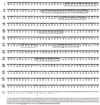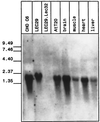Mammalian cytidine 5'-monophosphate N-acetylneuraminic acid synthetase: a nuclear protein with evolutionarily conserved structural motifs
- PMID: 9689047
- PMCID: PMC21305
- DOI: 10.1073/pnas.95.16.9140
Mammalian cytidine 5'-monophosphate N-acetylneuraminic acid synthetase: a nuclear protein with evolutionarily conserved structural motifs
Abstract
Sialic acids of cell surface glycoproteins and glycolipids play a pivotal role in the structure and function of animal tissues. The pattern of cell surface sialylation is species- and tissue-specific, is highly regulated during embryonic development, and changes with stages of differentiation. A prerequisite for the synthesis of sialylated glycoconjugates is the activated sugar-nucleotide cytidine 5'-monophosphate N-acetylneuraminic acid (CMP-Neu5Ac), which provides a substrate for Golgi sialyltransferases. Although a mammalian enzymatic activity responsible for the synthesis of CMP-Neu5Ac has been described and the enzyme has been purified to near homogeneity, sequence information is restricted to bacterial CMP-Neu5Ac synthetases. In this paper, we describe the molecular characterization, functional expression, and subcellular localization of murine CMP-Neu5Ac synthetase. Cloning was achieved by complementation of the Chinese hamster ovary lec32 mutation that causes a deficiency in CMP-Neu5Ac synthetase activity. A murine cDNA encoding a protein of 432 amino acids rescued the lec32 mutation and also caused polysialic acid to be expressed in the capsule of the CMP-Neu5Ac synthetase negative Escherichia coli mutant EV5. Three potential nuclear localization signals were found in the murine synthetase, and immunofluorescence studies confirmed predominantly nuclear localization of an N-terminally Flag-tagged molecule. Four stretches of amino acids that occur in the N-terminal region are highly conserved in bacterial CMP-Neu5Ac synthetases, providing evidence for an ancestral relationship between the sialylation pathways of bacterial and animal cells.
Figures






Similar articles
-
Nuclear localization signal of murine CMP-Neu5Ac synthetase includes residues required for both nuclear targeting and enzymatic activity.J Biol Chem. 2002 May 31;277(22):19688-96. doi: 10.1074/jbc.M201093200. Epub 2002 Mar 13. J Biol Chem. 2002. PMID: 11893746
-
Molecular cloning of a unique CMP-sialic acid synthetase that effectively utilizes both deaminoneuraminic acid (KDN) and N-acetylneuraminic acid (Neu5Ac) as substrates.Glycobiology. 2001 Aug;11(8):685-92. doi: 10.1093/glycob/11.8.685. Glycobiology. 2001. PMID: 11479279
-
CMP-sialic acid synthetase of the nucleus.Biochim Biophys Acta. 2004 Jul 6;1673(1-2):56-65. doi: 10.1016/j.bbagen.2004.04.006. Biochim Biophys Acta. 2004. PMID: 15238249 Review.
-
Cloning and expression of human sialic acid pathway genes to generate CMP-sialic acids in insect cells.Glycoconj J. 2001 Mar;18(3):205-13. doi: 10.1023/a:1012452705349. Glycoconj J. 2001. PMID: 11602804
-
CMP-Sialic Acid Synthetase: The Point of Constriction in the Sialylation Pathway.Top Curr Chem. 2015;366:139-67. doi: 10.1007/128_2013_477. Top Curr Chem. 2015. PMID: 24141690 Review.
Cited by
-
Lysine at position 329 within a C-terminal dilysine motif is crucial for the ER localization of human SLC35B4.PLoS One. 2018 Nov 20;13(11):e0207521. doi: 10.1371/journal.pone.0207521. eCollection 2018. PLoS One. 2018. PMID: 30458018 Free PMC article.
-
Construction and characterization of new piggyBac vectors for constitutive or inducible expression of heterologous gene pairs and the identification of a previously unrecognized activator sequence in piggyBac.BMC Biotechnol. 2007 Jan 18;7:5. doi: 10.1186/1472-6750-7-5. BMC Biotechnol. 2007. PMID: 17233894 Free PMC article.
-
Identification and biochemical characterization of two functional CMP-sialic acid synthetases in Danio rerio.J Biol Chem. 2012 Apr 13;287(16):13239-48. doi: 10.1074/jbc.M111.327544. Epub 2012 Feb 20. J Biol Chem. 2012. PMID: 22351762 Free PMC article.
-
Identification and characterization of important residues in the catalytic mechanism of CMP-Neu5Ac synthetase from Neisseria meningitidis.FEBS J. 2010 Jul;277(13):2779-90. doi: 10.1111/j.1742-4658.2010.07696.x. Epub 2010 May 20. FEBS J. 2010. PMID: 20491913 Free PMC article.
-
Therapeutic Monosaccharides: Looking Back, Moving Forward.Biochemistry. 2020 Sep 1;59(34):3064-3077. doi: 10.1021/acs.biochem.9b00565. Epub 2019 Aug 22. Biochemistry. 2020. PMID: 31398011 Free PMC article. Review.
References
Publication types
MeSH terms
Substances
Associated data
- Actions
Grants and funding
LinkOut - more resources
Full Text Sources
Other Literature Sources
Molecular Biology Databases

